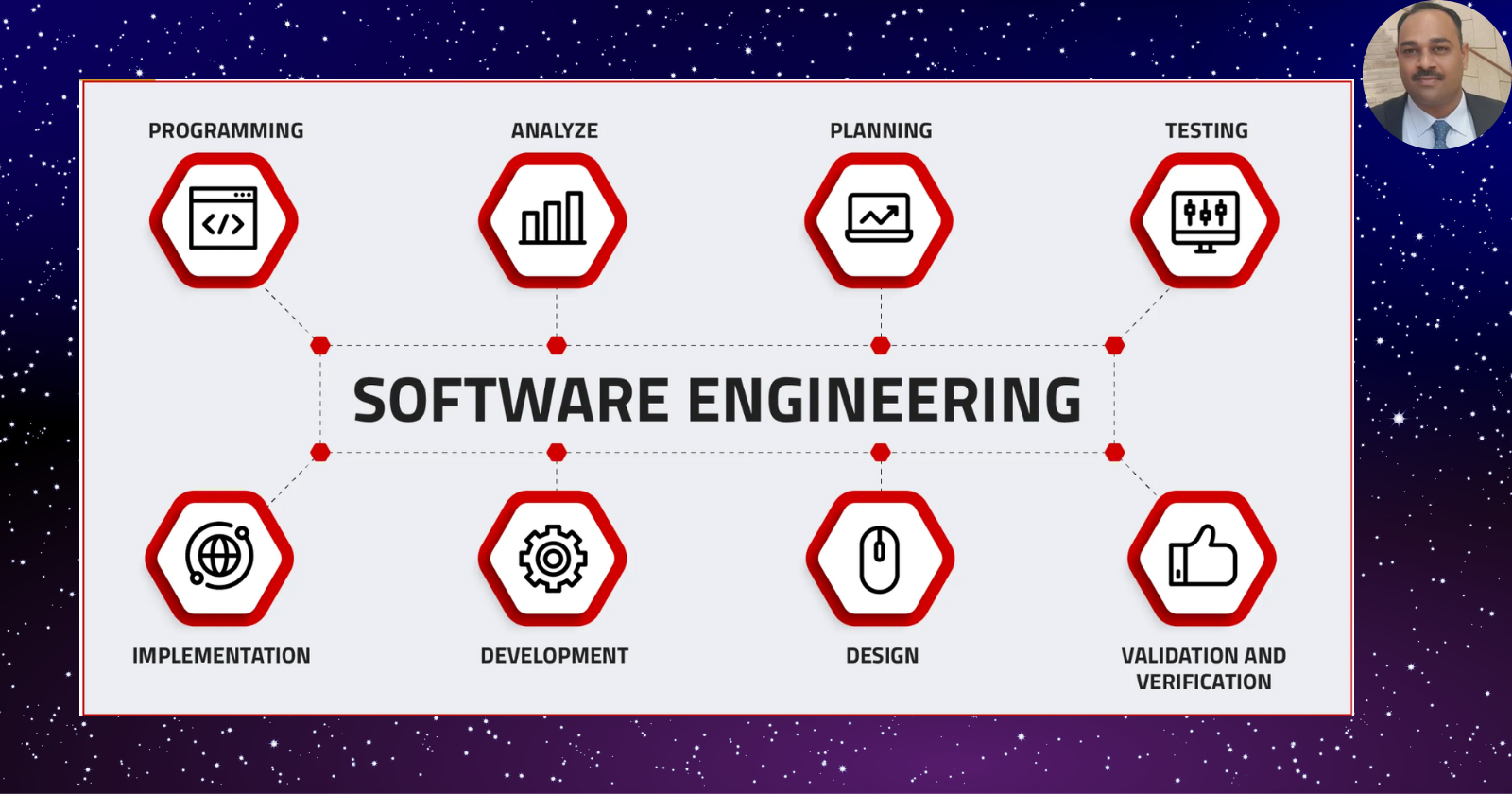The Symphony of Software Engineering: A Comprehensive Guide from Ideation to Deployment
 Prasana Kumar Parthasarathy
Prasana Kumar Parthasarathy
Overview
In the heart of the digital age, where every click, swipe and tap echoes innovation, software engineering emerges as the creative symphony behind our connected world. This blog is your backstage pass, guiding you through the enthralling acts of software development. We unravel the intricacies, exploring each phase with real-world examples, demystifying roles and responsibilities, and delving into industry best practices and vital metrics. Whether you're an aspiring engineer, a meticulous manager, or a visionary CTO, join me in deciphering the symphony that turns ideas into interactive realities.
Understanding the Essence of Software Engineering
At its core, software engineering is not just about writing lines of code; it’s a systematic approach to problem-solving. It’s about envisioning, designing, developing, testing, deploying, and maintaining software applications that meet specific needs. The essence of software engineering lies in its processes and methodologies, shaping the way teams collaborate and create.
Act 1: Conception & Composition
Setting the Stage: Ideation and Requirement Gathering
Our story begins in a room filled with brainstorming minds. Here, healthcare professionals, software developers, and user experience designers gather. The air is thick with ideas, and a shared vision emerges for a healthcare app that simplifies patient-doctor interactions. Everyone contributes their insights, forming the initial concept.
Composer's Notes: Defining the Vision and Scope
In the world of software engineering, ideas are the raw melodies. Like a composer, the team refines these melodies into a coherent theme. Healthcare experts bring industry insights, product managers define the app's purpose, functionalities, and the problems it solves and UX/UI designers craft intuitive interfaces. Best practices include thorough market research, clear feature definitions, and the implementation of responsive design for versatile user experiences. This initial composition sets the tone for the entire project, guiding every subsequent decision.
Best Practices:
Tools & Software Providers: Utilize tools like Jira/Trello/Smartsheets for project management, Balsamiq for wireframing, etc
Engineering Methods: Follow Agile methodologies for iterative development, fostering adaptability and collaboration.
Roles & responsibilities to start with:

Act 2: Composing the Score: Design & Planning
Harmonizing Elements: UX/UI Design and Architecture Planning
With the concept taking shape, architects design the software's backbone, project managers coordinate teams, and UX/UI designers refine interfaces. Architects prioritize architectural patterns, modularity, and flexible designs. Project managers utilize management tools, conduct regular planning meetings, and UX/UI designers perform A/B testing while staying abreast of design trends.
Conductor's Rehearsal: Prototyping and Feedback Loops
Just as a conductor rehearses with the orchestra, developers create prototypes. These prototypes are the first rehearsals of the software. They are tested internally, and feedback is collected. The iterative process of refining and testing mirrors a conductor refining the orchestra's performance, ensuring every element aligns perfectly.
Best Practices:
Tools & Software Providers: Leverage tools like Sketch, Figma and Adobe XD for interface design and validate cloud platforms such as AWS, Azure, GCP for robust cloud solutions.
Engineering Methods: Implement Scrum methodologies, using tools like Scrumwise for sprint planning, Kanban boards and backlog management.
Roles & responsibilities:

Act 3: Rehearsals: Development & Testing
Musicians at Work: Coding and Iterative Refinement
The development phase is where the musicians, our developers, bring the composition to life. They write the code, crafting each feature meticulously. Like musicians rehearsing their parts, developers iterate, refining the code until it resonates perfectly with the initial vision.
Critics' Corner: Quality Assurance and Bug Fixing
Meanwhile, QA & testers, the critics of our story, meticulously evaluate the software. They perform various tests, ensuring every function works flawlessly. Bugs, if found, are reported back to the developers, who then fine-tune their performance. This back-and-forth continues until the software is impeccable.
Developers, testers, and Scrum masters come together, transforming designs into functional code. Developers adhere to coding standards, employ version control, and foster collaboration. Testers embrace various testing types, utilizing automation tools for efficiency. Scrum masters champion continuous improvement and transparent communication within the team.
Best Practices:
Tools & Software Providers: Use version control systems like Git for collaboration and Jenkins/AWS Code Commit for continuous integration & continuous deployment.
Engineering Methods: Embrace DevOps practices, ensuring seamless collaboration between development and operations teams.
Roles & responsibilities:

Act 4: The Grand Performance: Deployment & Maintenance
Opening Night: Deployment and User Feedback
The software, now a polished masterpiece, steps onto the grand stage of the digital world. Users download the healthcare app, and the real performance begins. Users' interactions become the applause – their feedback guides the developers, allowing the software to evolve and improve.
Backstage Crew: DevOps and Continuous Monitoring
Behind the scenes, DevOps engineers act as the backstage crew, ensuring everything runs smoothly. They monitor servers, databases, and user activities. Their job is to make sure the performance (the app) and the stage (the servers) are in perfect harmony, guaranteeing a seamless experience for the audience (the users).
DevOps engineers manage deployments and configurations, ensuring stability. Customer support acts as a bridge between users and developers, resolving queries efficiently. Product managers analyze user feedback, ensuring the software evolves with changing needs. Best practices encompass automated deployments, efficient query handling, and continuous user feedback sessions.
The final act brings deployment and post-launch activities into focus. DevOps engineers manage deployments, ensuring stability and reliability. Customer support acts as the bridge between users and developers, resolving queries efficiently. Product managers, armed with user feedback, plan updates and ensure the software evolves with changing needs.
Best Practices:
Tools & Software Providers: Utilize deployment automation tools like Ansible, Terraform and other integration integrations such as AWS, GCP, Azure, Google Playstore for scalable deployments.
Engineering Methods: Implement Continuous Integration/Deployment (CD), allowing seamless and automatic deployment of code changes.

Metrics & KPIs
In Agile software development, there are various metrics and Key Performance Indicators (KPIs) that teams can use to measure their progress, productivity, and the quality of the software being developed. Prioritizing these metrics can depend on the specific goals and challenges of a project. Here's a list of some common Agile metrics, along with the top 5 that can be prioritized in each category
1. Productivity Metrics:
Velocity: Measures the amount of work a team completes during a sprint.
Throughput: Measures the number of user stories or features delivered over a period.
Lead Time: Measures the time taken from the request of a new feature to its deployment.
Cycle Time: Measures the time taken to complete one cycle of a user story from start to end.
Code Churn: Measures how often code is changed, indicating instability.
2. Quality Metrics:
Defect Rate: Measures the number of defects identified in a specific period.
Code/Test Coverage: Measures the percentage of code covered by automated tests.
Escape Rate: Measures the number of defects found by customers after release.
Customer Reported Issues: Measures the number of issues reported by customers.
Regression Rate: Measures how often previously working code breaks after changes.
Code Quality: Employ tools like SonarQube to measure code quality metrics, including code duplications, unit test coverage, and code complexity.
Defect Density: Track the number of defects per lines of code to identify code stability and quality.
Release Stability: Measure the number of post-release defects and their severity to assess the stability of released versions.
3. Predictability Metrics:
Burndown Chart: Visualizes completed work versus remaining work over time.
Burnup Chart: Shows the amount of work completed versus planned work over time.
Cumulative Flow Diagram: Visualizes the flow of work items across different stages.
Sprint Burndown: Shows work completed versus work planned for a specific sprint.
Release Burndown: Tracks work completed versus planned for the entire release.
4. Team Collaboration Metrics:
Collaboration Index: Measures the level of collaboration within the team.
Daily Standup Participation: Measures the team members' participation in daily standup meetings.
Pair Programming Ratio: Measures the percentage of time team members spend pair programming.
Code Review Effectiveness: Measures the quality of code reviews based on identified issues.
Retrospective Action Items Completed: Measures the completion of action items identified in retrospectives.
Team Collaboration: Utilize tools like Slack for team communication and track response times and message volume for collaboration efficiency.
5. Customer Satisfaction Metrics:
Net Promoter Score (NPS): Measures customer satisfaction and loyalty based on a survey.
Customer Satisfaction Surveys: Regular surveys to collect feedback on product features and usability.
Customer-reported Defect Severity: Measures the impact of defects reported by customers.
Customer Support Response Time: Measures how quickly customer support responds to customer issues.
User Engagement Metrics: Measures how often and how long users are engaging with the software.
When prioritizing these metrics, it's crucial to align them with the project goals and customer expectations. For example, if customer satisfaction is a top priority, metrics like NPS and Customer Satisfaction Surveys should be given high importance. Similarly, if the focus is on improving team collaboration, metrics like Collaboration Index and Pair Programming Ratio should be prioritized. Agile teams often tailor their choice of metrics based on their unique context and objectives.
Innovation at the Heart: Few Emerging Trends in Software Engineering
Artificial Intelligence and Machine Learning: Integrating AI and ML algorithms into software applications, enabling them to learn, adapt, and improve over time.
Blockchain Technology: Transforming the way transactions are conducted, ensuring security, transparency, and traceability.
Internet of Things (IoT): Interconnecting devices, revolutionizing sectors like healthcare, manufacturing, FinTech, Smart Cities/homes and many others.
Quantum Computing: Pioneering the future of computational power, solving problems deemed unsolvable by classical computers.
Conclusion
In the ever-evolving landscape of software engineering, understanding the orchestra of roles, tools, and metrics is pivotal. The software development process is not just about writing code; it's a symphony of collaboration, innovation, and user-centricity. Armed with this knowledge, aspiring geeks find their compass, managers lead with precision, and CTOs innovate fearlessly. Each act seamlessly transitions into the next, creating a harmonious narrative. The composers and musicians envision the melody, the designers and architects score it, the developers and testers rehearse it, and the users provide the applause. DevOps ensures the stage is set for this grand performance, and the cycle continues, with every performance inspiring the next composition.
As the curtains fall on this symphony, remember every line of code, every user query resolved, and every update planned, contributes to the perpetual evolution of software engineering. Embrace the symphony, and let digital compositions resonate in the hearts of users worldwide.
I hope this blog serves as a stepping stone, empowering individuals to navigate the complexities of software engineering with clarity and confidence. Hoping this blog be your muse, guiding light, and source of inspiration. As you embark on your technological endeavors, may you find success in every line of code and innovation.
Thank you and Happy Coding, Engineering & reading as well! ❤👍 (you can subscribe to my newsletter and will be notified the moment I post).
Note: All images, keywords or any other elements used belong to respective owners.
Subscribe to my newsletter
Read articles from Prasana Kumar Parthasarathy directly inside your inbox. Subscribe to the newsletter, and don't miss out.
Written by

Prasana Kumar Parthasarathy
Prasana Kumar Parthasarathy
A versatile professional having 20+ years of profound experience in Product Management, Customer Solutions & Consulting, CX & Digital Transformation, Technology Engineering in terms of Architecture, Design and scalable solutions, Go-to-Market Strategy, Presales & Sales Engineering, P&L Management, Channel Management, Cross Functional Leadership, Project Management, Solution Delivery and Biz Development in an organization of high repute.